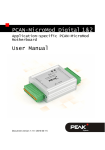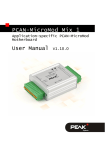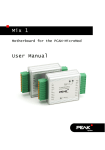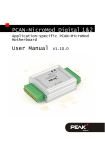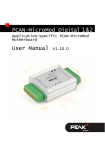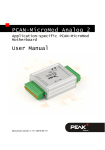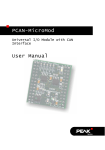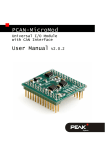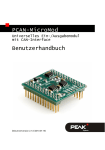Download PCAN-MicroMod Mix 2 - User Manual - PEAK
Transcript
PCAN-MicroMod Mix 2 Application-specific PCAN-MicroMod Motherboard User Manual Document version 1.11.1 (2014-03-11) PCAN-MicroMod Mix 2 – User Manual Products taken into account Product Name Model Part number PCAN-MicroMod Mix 2 Including casing and PCAN-MicroMod IPEH-002203 PCAN-MicroMod Configuration Version 2.5 (Windows software) CANopen® and CiA® are registered community trade marks of CAN in Automation e.V. All other product names mentioned in this document may be the trademarks or registered trademarks of their respective companies. They are not explicitly marked by “™” and “®”. © 2014 PEAK-System Technik GmbH PEAK-System Technik GmbH Otto-Roehm-Strasse 69 64293 Darmstadt Germany Phone: +49 (0)6151 8173-20 Fax: +49 (0)6151 8173-29 www.peak-system.com [email protected] Document version 1.11.1 (2014-03-11) 2 PCAN-MicroMod Mix 2 – User Manual Contents 1 1.1 1.2 1.3 2 2.1 2.2 2.3 3 Introduction 4 Properties at a Glance Prerequisites for Operation Scope of Supply Hardware Configuration 4 6 6 7 Pull-up/Pull-down Circuits for the Digital Inputs Measuring Range Extension of the Analog Inputs Using a PT1000 with Three-Wire Connection Operation 8 9 10 11 3.1 Port Assignment 3.2 Configuration Program 3.2.1 System Prerequisites 3.2.2 Installing the Program 3.2.3 Creating a Configuration 3.2.4 Applicable MicroMod Services 3.2.5 Relation Temperature/Digits 3.3 Status LEDs 3.4 Several MicroMods on the CAN Bus 11 12 12 13 13 14 16 17 17 4 19 Technical Specifications Appendix A CE Certificate 22 Appendix B Dimension Drawing 23 3 PCAN-MicroMod Mix 2 – User Manual 1 Introduction The motherboards for PCAN-MicroMod provide an applicationoriented environment. Typical characteristics of this product group include a wide supply voltage range and the protective circuit for the inputs and outputs. CANopen® firmware is available for all PCAN-MicroMod motherboards. The Mix 2 motherboard serves common analog and digital requirements and supports temperature measurement. Note: This manual only refers to the motherboard as base for a PCAN-MicroMod and to the standard firmware. For the PCANMicroMod and the configuration program PCAN-MicroMod Configuration, there is separate documentation. 1.1 Properties at a Glance Completely configurable using the Windows program PCANMicroMod Configuration Communication through High-speed CAN (ISO 11898-2) Operating voltage 11 to 26 V (8 to 26 V w/o use of analog outputs) Aluminum profile casing with spring terminal connectors Top hat rail mounting option available Extended operating temperature range from -40 to +85 °C (-40 to +185 °F) 4 PCAN-MicroMod Mix 2 – User Manual 2 digital inputs: • Pull-up or pull-down circuit selectable (for both together) • High state at 5 to 18 V input voltage • Schmitt trigger behavior, inverting • Low-pass behavior • Parallel connection of a frequency input for alternative use (e.g. fast status changes, countings) 2 inputs for connecting a thermistor and a platinum sensor PT1000, measuring range each 0 to 70 °C (32 to 158 °F) 3 analog inputs: • Pull-down circuit • Measuring range unipolar 0 to 4.1 V • Resolution 10 bits • Sampling rate 1 kHz • Measuring range extension possible • Low-pass behavior • Protection against undervoltage and overvoltage 1 digital output: • Fast low-side switch, max. 55 V, 0.75 A • Short circuit protection 1 analog voltage output: • Voltage range 0 to 10 V (based on 16-bit PWM) • Load ability: 15 mA, short-circuit proof 1 analog current output with 0 to 20 mA (based on 16-bit PWM) Status LEDs for power supply and digital output 5 PCAN-MicroMod Mix 2 – User Manual 1.2 Prerequisites for Operation Power supply in the range of 11 to 26 V DC (8 to 26 V w/o use of analog outputs) For creating and transferring configurations: computer with Windows 8, 7, Vista, XP (32-bit or 64-bit) and a CAN interface from the PCAN series 1.3 Scope of Supply PCAN-MicroMod PCAN-MicroMod motherboard in casing including mating connectors PCAN-MicroMod Configuration for Windows Manual in PDF format 6 PCAN-MicroMod Mix 2 – User Manual 2 Hardware Configuration You can customize the motherboard by modifying the hardware. The following subsections contain descriptions about possible modifications. Accessing the Motherboard In order to carry out the modifications described in the following sections, unscrew the lid of the casing and pull off the MicroMod from the motherboard. Attention! Electrostatic discharge (ESD) can damage or destroy components on the motherboard or the PCAN-MicroMod. Take precautions to avoid ESD when handling the boards. Remounting the MicroMod When you remount the MicroMod, take notice of the white triangular marks on each the motherboard and the MicroMod (upper left corner). These marks must align. Figure 1: Positioning of the MicroMod 7 PCAN-MicroMod Mix 2 – User Manual 2.1 Pull-up/Pull-down Circuits for the Digital Inputs At delivery the digital inputs are set to pull-up circuits. You can set them together to pull-down circuit. This is done by repositioning a 0-Ohm resistor. * Digital inputs Pull-up (+Ub)* Pull-down (GND) DI 0 and DI 1 R73 (0 Ω) R74 (0 Ω) Setting at delivery Figure 2: Position R73/R74 (bottom side of the PCB) Attention! Double-check for an inadvertent short circuit after altering the setup. 8 PCAN-MicroMod Mix 2 – User Manual 2.2 Measuring Range Extension of the Analog Inputs You can extend the measuring range of each analog input to a higher maximum voltage than 4.1 Volts by using a voltage divider. On delivery of the motherboard the resistor positions R28 to R30 on the bottom side of the PCB are not equipped. By inserting a resistor Rx with a value calculated with the following formula the measuring range is extended to the desired maximum voltage UMB. Rx = 2400 Ω (UMB > 4.1V) UMB −1 4.1V Figure 3: Position R28 to R30 (bottom side of the PCB) 9 PCAN-MicroMod Mix 2 – User Manual 2.3 Using a PT1000 with Three-Wire Connection At delivery the Mix 2 motherboard is configured to be used with a PT1000 thermistor with two-wire connection. If you would like to use a PT1000 with three-wire connection instead (e.g. in case of a long connection cable), you must remove the 0-Ohm resistor on the PCB located on position R76. Figure 4: Position R76 10 PCAN-MicroMod Mix 2 – User Manual 3 Operation 3.1 Port Assignment The motherboard has two connectors, J1/2 on the left and J3 on the right. The port assignment is as follows: Figure 5: Ports of the Mix 2 motherboard Port name J1/2 Function +Ub Operating voltage 11 - 26 V DC, w/o AOut 8 - 26 V DC GND Digital ground CAN_L CAN_H N/C Differential CAN signal Not connected AIn 0 AIn 1 Analog input AIn 2 AIn 3 (NTC) Connection thermistor (against AGND) AGND Analog ground 11 PCAN-MicroMod Mix 2 – User Manual Port name J3 Function GND Digital ground DOut 0 Digital output DIn 1 DIn 0 Digital input AOut 1 Analog output for current (PWM) AOut 0 Analog output for voltage (PWM) PTE PT2 PT1 AGND 3.2 Temperature measurement PT1000 Reference point Input Input Analog ground Configuration Program In order to create and transfer MicroMod configurations the Windows software PCAN-MicroMod Configuration is used. This section covers basic points about installation and use of the program with the Mix 2 motherboard. You'll find detailed information about the use of PCAN-MicroMod Configuration in the related documentation which is invoked via the program (e.g. with F1). 3.2.1 System Prerequisites Windows 8, 7, Vista, XP (32-bit or 64-bit) Computer with CAN interface of the PCAN series (for transferring a configuration to the PCAN-MicroMod via CAN) 12 PCAN-MicroMod Mix 2 – User Manual 3.2.2 Installing the Program Under Windows install the program from the supplied CD. Start the corresponding installation routine by using the CD navigation going to Tools > PCAN-MicroMod Configuration 2.5.x. 3.2.3 Creating a Configuration When you start creating a new configuration in PCAN-MicroMod Configuration, the dialog box Board Type appears in order to select the type of the used motherboard. The necessary settings are explained in the following. Figure 6: PCAN-MicroMod Configuration: selection of the Mix 2 motherboard Board Type: PCAN-MicroMod Mix 2 Module No: 0 The module number of the MicroMod on the Mix 2 motherboard is set to 0 at delivery and is relevant if you want to configure more than one MicroMod on the same CAN bus. See also section 3.4 Several MicroMods on the CAN Bus on page 17. 13 PCAN-MicroMod Mix 2 – User Manual Bitrate MicroMod: 500 kbit/s At delivery the MicroMod is set to a bit rate of 500 kbit/s. A change of this setting will take effect after sending the completed configuration to the MicroMod. Note: For the first transfer of a configuration to the module it must be integrated in a CAN network with a bit rate of 500 kbit/s. 3.2.4 Applicable MicroMod Services The motherboard's inputs and outputs are controlled by the services of the MicroMod. The following table shows the assignment of the motherboard functions to the MicroMod services. Function on motherboard Port name Digital input DIn 0, DIn 1 Access with MicroMod service(s) Digital Input Digital Function Rotary Encoder Frequency input (parallel to channels DIn 0 and DIn 1) Frequency Input Digital output (higherfrequent state changes are not possible) DOut 0 Temperature measurment thermistor (see also table in section 3.2.5 on page 16) AIn 3 (NTC) Temperature measurement PT1000 PTx Digital Output Analog Input Curve Analog Input Curve Analog input (see also table in AIn 2, AIn 3 section 3.2.5 on page 16) Analog Input Curve Analog Hysteresis 14 PCAN-MicroMod Mix 2 – User Manual Function on motherboard Port name Analog output for voltage AOut 0 Analog output for current (inverting) AOut 1 LED DOut 7 DOut 7 Access with MicroMod service(s) PWM and Frequency Output (4 kHz recommended for PWM) PWM and Frequency Output (4 kHz recommended for PWM) Digital Output 15 PCAN-MicroMod Mix 2 – User Manual 3.2.5 Relation Temperature/Digits Since the NTC thermistor does not provide a linear correlation between temperature and the resulting voltage, the use of interpolation values can be expedient. With these values you can create a mapping curve with the corresponding MicroMod service. For the PT1000 this procedure is not necessarily needed, because it works almost linear in the defined temperature range. The following table provides the mapping between a temperature and the resulting voltage or the digits respectively. * Temperature Digits* (°C) NTC Digits* PT1000 0 1023 2 2 1010 36 5 974 89 10 911 164 15 841 235 20 765 310 25 683 380 30 602 455 35 516 524 40 432 598 45 348 668 50 268 742 55 192 812 60 121 886 65 57 956 70 3 1023 1 digit ≡ 4 mV 16 PCAN-MicroMod Mix 2 – User Manual 3.3 Status LEDs The motherboard including the MicroMod has three LEDs with the following status indications: LED Indication Power (green) Power is applied. DOut 7 (red) Is linked to the digital output DO 7 of the MicroMod and can be configured freely. Activity (red) Status of the PCAN-MicroMod: blinking at 1 Hz normal operation blinking at 2 Hz invalid or no configuration blinking at 5 Hz configuration mode continuously on internal MicroMod error 3.4 Several MicroMods on the CAN Bus If you want to use several MicroMods on the same CAN bus and want to configure them, each one needs its own module number. That way the MicroMods are distinguishable for the program PCANMicroMod Configuration. The module number is set on the MicroMod by solder jumpers and lies in the range of 0 to 31. At delivery each MicroMod has the module number 0. During normal operation of the PCAN-MicroMod, the module number has no effect on the CAN communication. For setting the solder jumpers on the MicroMod unscrew the top of the casing and remove the MicroMod from the motherboard. Please find further information about the assignment of module numbers in the separate manual for the PCAN-MicroMod. 17 PCAN-MicroMod Mix 2 – User Manual Attention! Electrostatic discharge (ESD) can damage or destroy components on the motherboard or the PCAN-MicroMod. Take precautions to avoid ESD when handling the boards. Remounting the MicroMod When you remount the MicroMod, take notice of the white triangular marks on each the motherboard and the MicroMod (upper left corner). These marks must align. Figure 7: Positioning of the MicroMod 18 PCAN-MicroMod Mix 2 – User Manual 4 Technical Specifications Power supply Operating voltage +Ub 11 - 26 V DC (±5 %), 8 - 26 V w/o AOut Current consumption max. 200 mA, typ. 35 mA at 12 V w/o load Overvoltage protection ±30 V static, ±500 V surge Ripple 5 V < 50 mV (+Ub = 12 V, 200 mA load) Ripple analog < 20 mV Reverse-polarity protection extant; can get ineffective by the wiring with other CAN nodes (danger of destruction of electronic components) Analog inputs Count 3 Measuring range 0 to 4.1 V, extendable Resolution 10 bits Sampling rate 1 kHz Source impedance < 5 kΩ Overvoltage protection extant Low-pass fg = 66 Hz Analog outputs Count 2 Type PWM based Voltage AOut 0 0 - 10 V Resolution 16 bits Load ability AOut 0 15 mA Current AOut 1 0 to 20 mA (inverting) Load resistance AOut 1 < 100 Ω 19 PCAN-MicroMod Mix 2 – User Manual Temperature input thermistor Count 1 Reference sensor type Thermistor EC95F103W (e.g. RS Components part no. 151-237, form factor: bead) 1 Measuring range 0 to 70 °C (32 to 158 °F) corresponding 4.1 to 0 V (antiproportional)1 Resolution ±1.0 °C (due to sensor) Temperature input PT1000 Count 1 Sensor type PT1000, two- or three-wire connection Measuring range 0 to 70 °C (32 to 158 °F) corresponding 0 to 4.1 V Resolution 10 bit Resolution ±0,5 °C Digital inputs Count 2 Switching thresholds UIH = 4 V; UIL = 3 V, contact or logic level Input impedance 2.7 kΩ Open input Pull-up circuit, optional pull-down circuit Overvoltage protection extant Low-pass fg = 7 kHz Special feature Frequency inputs of the PCAN-MicroMod parallel Digital/frequency output 1 Count 1 Maximum frequency 10 kHz (details: see user manual for the PCAN-MicroMod) Type Low-side Voltage proof < 55 V Output current 0.75 A (constant current) Short circuit protection extant; short-circuit current: 1.2 A Other sensor type and measuring range on request 20 PCAN-MicroMod Mix 2 – User Manual CAN Transmission standard High-speed CAN ISO 11898-2, typ. 500 kbit/s, setup with PCAN-MicroMod Configuration (Windows software) Termination none CAN ID reserved for configuration transfer 0x7E7 Module number at delivery 0 (for configuration transfer) Peculiarity Interference Immunity Tests compliant to IEC 61000 and DIN EN 61326 Surge ±500 V (specification industrial sector: ±1 kV) 2 Line-conducted HF compatibility 10 Veff (specification: 3 Veff) Environment Operating temperature -40 - +85 °C (-40 - +185 °F) Temperature for storage and transport -40 - +100 °C (-40 - +212 °F) Relative humidity 15 - 90 %, not condensing Ingress protection (IEC 60529) IP20 EMC DIN EN 61326-1:2013-07 EC directive 2004/108/EG Measures 2 Casing size (incl. connectors) 55 x 68 x 24 mm See also dimension drawing in Appendix B on page 23 Weight 109 g This specification could only be fulfilled with ±500 V due to the available space. Therefore, the motherboard should be used with a local power supply. 21 PCAN-MicroMod Mix 2 – User Manual Appendix A CE Certificate 22 PCAN-MicroMod Mix 2 – User Manual Appendix B Dimension Drawing Figure 8: Top view and view of front side with connector. The figure does not show the actual size of the product. 23























